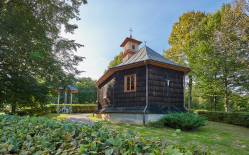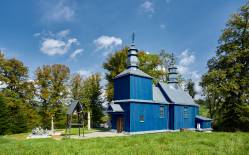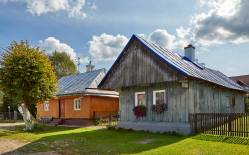The tserkva was probably built in 1743. In 1946 it was taken over as a Roman Catholic church. It has been extensively renovated several times, including in the mid-1960s, when it temporarily passed under the management of the Folk Architecture Museum in Sanok.
Inside there is a preserved iconostasis from 1875 and several 19th-century icons from the non-existent tserkva in Mrzygłód. The adaptation of the temple for the Latin liturgy took place without much interference with the tserkva's interior design. However, modern wall cladding with paneling and coffers has covered the original polychrome.
The building is of log structure, tripartite, oriented. The roof is of ridge structure; over the chancel there is a lower multi-pitched roof. Above the nave there is a steeple with a full lantern, and above the chancel there is a smaller bubble style turret. Roofs and walls are covered with shingles. A small vestibule with an overbuilt belfry storey is divided by a separate eaves roof. Architecturally, the building is an example of the Latin influences on the Orthodox church style. Surrounding the temple is a monumental ancient forest.
Gallery

Recommended venues on the Trail



This website has been modernized with the financial support of the European Union under the Cross-Border Cooperation Programme Poland-Belarus-Ukraine 2014-2020. The responsibility for its content lies solely with the Podkarpackie Regional Tourism Board and cannot, in any case, be treated as a reflection of the position of the European Union, the Managing Authority, or the Joint Technical Secretariat of the Cross-Border Cooperation Programme Poland-Belarus-Ukraine 2014-2020.













